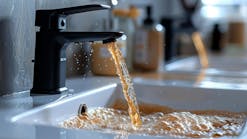The plumbing and life support equipment for the 1,100-gal saltwater fish tank at the new U.S. headquarters of GF Piping Systems in Irvine, Calif., is a microcosm of the complex systems installed in some of the largest commercial aquariums around the world.
This particular fish tank measures 5 ft wide by 5 ft deep by 6 ft long and weighs in at approximately 11,000 lb, but is tiny compared with the scale of main tank exhibits at modern public aquariums. For example, whale sharks and many other fish species reside in a 6.3-million-gal tank at the Georgia Aquarium in Atlanta. The Abbott Oceanarium at the Shedd Aquarium in Chicago includes a 3-million-gal home for dolphins, beluga whales, sea otters, sea lions and penguins, while giant sunfish and grouper swim comfortably in a 1.3-million-gal tank in Lisbon, Portugal.
Different Sizes, Same Equipment
Three orders of magnitude separate the size of these world-class exhibits from the modest saltwater tank serving as the centerpiece in GF Piping Systems’ market segment showroom, but there are similarities in the equipment and systems used in each. The water must be circulated, filtered, sterilized and replenished when lost due to evaporation, splashing and waste discharge. Additionally, water quality, whether saltwater or freshwater, must be maintained.
Plastic piping systems are used to help avoid corrosion for the health of the aquatic animals, enhance system aesthetics and minimize maintenance costs. As a supplier of plastic pipe, fittings, manual and actuated valves, and sensors and instrumentation for a variety of industrial and commercial applications, GF Piping Systems designed its saltwater fish tank specifically to demonstrate product capabilities for public aquariums and water parks, and for broader use in the water treatment market in general.
Tank Design & Operation
The tank was constructed and installed by Acrylic Tank Mfg. (ATM) and was featured on Animal Planet’s reality TV show, Tanked. ATM also selected and arranged the life support equipment, such as pumps, biological and membrane filters, ozonator, ultraviolet (UV) sterilizer and protein skimmer. GF Schedule 80 PVC and ecoFIT polyethylene pipe and fittings, plus more than a dozen manual ball and diaphragm valves, were used for the interconnecting piping systems, water supply and waste drainage.
GF Signet sensors and associated instruments mounted in an adjacent control panel are used to monitor dissolved oxygen; conductivity for salinity; temperature; hydrostatic pressure for level; oxidation-reduction potential for ozone; turbidity for water clarity; and paddlewheel and insertion mag flow sensors for filter circulation and UV balancing. The ORP sensor is installed in a “wet-tap” assembly that enables easy maintenance access without having to shut down the system. This degree of instrumentation is overkill for such a modestly sized fish tank, but is common in almost every major exhibit at public aquariums around the world.
In order to maintain a clean, clear and healthy tank, it is necessary to drain some of the water and replace it with “fresh” saltwater every week or so. A flow-based batch system is used to facilitate this routine bit of maintenance. The operator initiates the preprogrammed batch cycle with the press of a button. Doing so opens an electrically actuated ball valve, allowing water to drain by gravity to the sewer. A sensor/controller combination monitors the flow of water from the tank to the drain and closes the actuated valve when the desired volume is reached. Salt is mixed manually with deionized water produced on site, then the new saltwater is pumped into the tank to replenish the amount drained. This process is often fully automated on larger systems.
Systems for Life
GF Piping Systems plans to exhibit relevant products and present details of the design and operation of the saltwater fish tank at the 2015 Aquatic Animal Life Support Operators technical symposium, which will be hosted by Newport Aquarium and the Cincinnati Zoo, March 29 to April 2 in Cincinnati. This organization encourages the advancement of the science and technology of life support for the care of aquatic systems and animals, and provides a forum for life support operators, professionals and industry leaders to exchange information, ideas and experience to enhance stewardship of the animals in their care. Delegates from public aquariums large and small, domestic and international attend the workshops during this annual gathering to learn about new products.
One example is GF Piping Systems’ new Type 578 lug-style butterfly valve, available in sizes from 2 to 12 in. The valve is ideal for aquarium applications, and to promote it, the company created a giant 48-in.-diameter model measuring 12 ft tall with a 10-ft-long handle that was integrated into the fish tank installation. Together with the other manual and actuated valves, piping systems and instrumentation on the showroom fish tank, this new valve completes a package for commercial aquarium projects of any scale.
Download: Here



